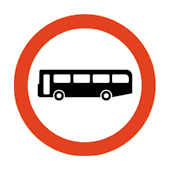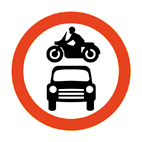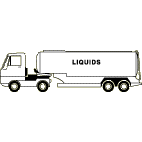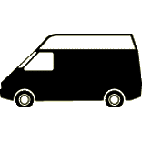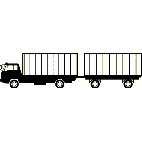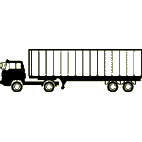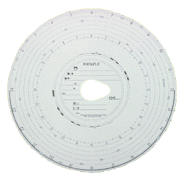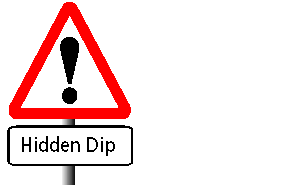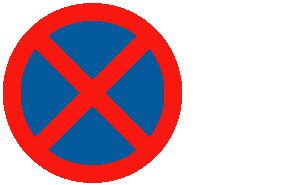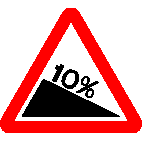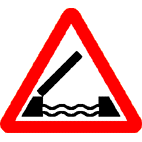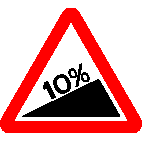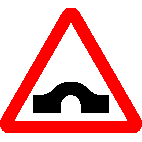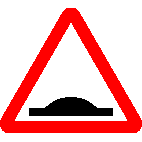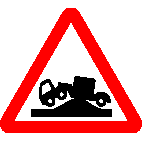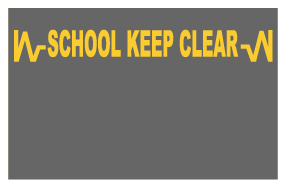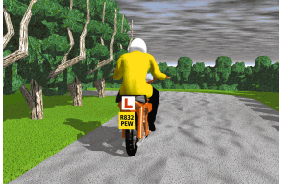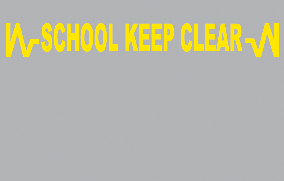You have 115 minutes (1 hour 55 minutes) to answer 100 multiple choice LGV theory test questions. You must score at least 85 out of 100 to pass the test. Answers may be checked after each question or you can wait until the end of the test to view your results. Good luck!
LGV Theory Test Practice (2024)
Test Quick View
Click question box to reveal the correct answer. You can print these questions out by clicking the printer icon.
B
C
D
Correct Answer: D
Explanation: White boxes allow you to unload at any time, but during the day the length of stay is restricted. You should check nearby signs for the specific times. At other times, when it's not so busy, there may not be any restrictions on parking.
Explanation: White boxes allow you to unload at any time, but during the day the length of stay is restricted. You should check nearby signs for the specific times. At other times, when it's not so busy, there may not be any restrictions on parking.
2. You're often involved in the carrying of high-value goods. What security measures can you adopt?
Mark one answer
B
C
D
Correct Answer: D
Explanation: When carrying high-value goods, you can become a target for thieves. Avoid developing a set routine or pattern. Vary your routes whenever possible to make it difficult for thieves to predict when and where your cargo can be intercepted.
Explanation: When carrying high-value goods, you can become a target for thieves. Avoid developing a set routine or pattern. Vary your routes whenever possible to make it difficult for thieves to predict when and where your cargo can be intercepted.
Correct Answer: D
Explanation: It's important to work methodically when uncoupling or recoupling a tractor unit and trailer. After recoupling, check that all connections, systems and lights are working correctly.
Explanation: It's important to work methodically when uncoupling or recoupling a tractor unit and trailer. After recoupling, check that all connections, systems and lights are working correctly.
Correct Answer: C
Explanation: When securing a load, the driver must use the most suitable type of restraint. Scrap metal is likely to have sharp edges that could wear through straps or ropes. Security of the load is the driver's responsibility; a load that has been correctly secured shouldn't move if an emergency arises.
Explanation: When securing a load, the driver must use the most suitable type of restraint. Scrap metal is likely to have sharp edges that could wear through straps or ropes. Security of the load is the driver's responsibility; a load that has been correctly secured shouldn't move if an emergency arises.

B
C
D
Correct Answer: C
Explanation: 60 mph may be the legal speed limit for a goods vehicle on a dual carriageway in England and Wales, but it doesn't mean that it's safe to drive at that speed. You should always take into account the road, weather and traffic conditions, and maintain safety margins.
Explanation: 60 mph may be the legal speed limit for a goods vehicle on a dual carriageway in England and Wales, but it doesn't mean that it's safe to drive at that speed. You should always take into account the road, weather and traffic conditions, and maintain safety margins.
Correct Answer: B
Explanation: No motor vehicles are allowed past this sign. Although a motorcycle and car are shown, the restriction applies to all motor vehicles.
Explanation: No motor vehicles are allowed past this sign. Although a motorcycle and car are shown, the restriction applies to all motor vehicles.
7. What could happen if you drive a double-deck lorry with the top deck loaded and the lower deck empty?
Mark one answer
B
C
D
Correct Answer: B
Explanation: If you're only carrying half a load on a double-deck lorry, this should be carried on the lower deck whenever possible. With only the top deck loaded, your lorry is top-heavy and at risk of overturning as you drive around bends or corners.
Explanation: If you're only carrying half a load on a double-deck lorry, this should be carried on the lower deck whenever possible. With only the top deck loaded, your lorry is top-heavy and at risk of overturning as you drive around bends or corners.
Correct Answer: D
Explanation: You should tell telephone companies about your intended route when planning the movement of loads over 5.25 metres [17 feet 6 inches] high. You should tell them in plenty of time before making the journey.
Explanation: You should tell telephone companies about your intended route when planning the movement of loads over 5.25 metres [17 feet 6 inches] high. You should tell them in plenty of time before making the journey.
9. Before starting driving, which of the following should you complete on the centre field of your tachograph chart?
Mark one answer
B
C
D
Correct Answer: D
Explanation: Before starting your journey, you must record a number of items on your tachograph chart. One of these is where the journey begins.
Explanation: Before starting your journey, you must record a number of items on your tachograph chart. One of these is where the journey begins.
10. You're on a motorway. Your lorry has a maximum authorised mass of more than 7.5 tonnes. What does this sign mean to you?
Mark one answer
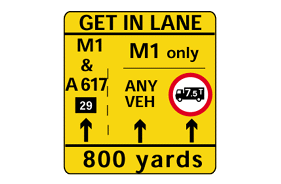
B
C
D
Correct Answer: D
Explanation: At motorway roadworks, some lanes may be narrower than normal and large vehicles may not be allowed to use those lanes. Look for weight-limit signs to check for any lanes that you can't use. Move to the appropriate lane in good time.
Explanation: At motorway roadworks, some lanes may be narrower than normal and large vehicles may not be allowed to use those lanes. Look for weight-limit signs to check for any lanes that you can't use. Move to the appropriate lane in good time.
Correct Answer: D
Explanation: The service brake is usually operated by the brake pedal. It's used to control the speed of the vehicle and to bring it to a halt safely. It may also incorporate an anti-lock braking system.
Explanation: The service brake is usually operated by the brake pedal. It's used to control the speed of the vehicle and to bring it to a halt safely. It may also incorporate an anti-lock braking system.
Correct Answer: C
Explanation: Take care if you're driving an empty high-sided vehicle when it's windy. Watch for places where the conditions could suddenly change, such as a gap between buildings or when passing under a bridge. Reduce your speed and stay alert for other road users who are also affected by these weather conditions.
Explanation: Take care if you're driving an empty high-sided vehicle when it's windy. Watch for places where the conditions could suddenly change, such as a gap between buildings or when passing under a bridge. Reduce your speed and stay alert for other road users who are also affected by these weather conditions.
13. You're driving a lorry towards a high bridge on a windy day. What should you expect?
Mark one answer
B
C
D
Correct Answer: B
Explanation: In windy weather, exposed stretches of road may have lane closures or there may be diversions for some types of vehicle. Consider this when you're planning your journey; delays will add to your driving time.
Explanation: In windy weather, exposed stretches of road may have lane closures or there may be diversions for some types of vehicle. Consider this when you're planning your journey; delays will add to your driving time.
Correct Answer: A
Explanation: High-sided vehicles are severely affected by side wind because of the large surface area of the bodywork. The risk of loss of control is increased if the vehicle is unladen.
Explanation: High-sided vehicles are severely affected by side wind because of the large surface area of the bodywork. The risk of loss of control is increased if the vehicle is unladen.
B
C
D
Correct Answer: C
Explanation: If you change vehicles during the working day, you should take your chart with you and use it in the next vehicle. This isn't always possible, however, as charts produced by different manufacturers may not be interchangeable. In this case, you should use another chart, making sure that all the information for the day is recorded.
Explanation: If you change vehicles during the working day, you should take your chart with you and use it in the next vehicle. This isn't always possible, however, as charts produced by different manufacturers may not be interchangeable. In this case, you should use another chart, making sure that all the information for the day is recorded.
B
C
D
Correct Answer: B
Explanation: You should always be aware of the amount of room your trailer needs when it's going around bends and corners. If you need to go onto the other side of the road, make sure there's no oncoming traffic before you move out.
Explanation: You should always be aware of the amount of room your trailer needs when it's going around bends and corners. If you need to go onto the other side of the road, make sure there's no oncoming traffic before you move out.
Correct Answer: A
Explanation: Roll-over' usually happens as a result of the inside rear wheels of an articulated vehicle starting to lift when the driver changes direction sharply. This tends to happen when a driver is changing direction to leave a roundabout. If the load moves during the change of direction, the vehicle is increasingly at risk of rolling over. The problem often involves vehicles carrying fluids in bulk.
Explanation: Roll-over' usually happens as a result of the inside rear wheels of an articulated vehicle starting to lift when the driver changes direction sharply. This tends to happen when a driver is changing direction to leave a roundabout. If the load moves during the change of direction, the vehicle is increasingly at risk of rolling over. The problem often involves vehicles carrying fluids in bulk.
Correct Answer: C
Explanation: The hours of operation of Red Routes vary from one area to another. As a rule, you mustn't stop on a Red Route, but there may be special marked boxes where loading and unloading can be carried out at certain times. Look out for signs giving information about the restrictions in place.
Explanation: The hours of operation of Red Routes vary from one area to another. As a rule, you mustn't stop on a Red Route, but there may be special marked boxes where loading and unloading can be carried out at certain times. Look out for signs giving information about the restrictions in place.
B
C
D
Correct Answer: B
Explanation: A fifth wheel must be maintained properly. It requires regular lubrication and inspection. This should be carried out monthly or every 10 000 km - whichever comes first.
Explanation: A fifth wheel must be maintained properly. It requires regular lubrication and inspection. This should be carried out monthly or every 10 000 km - whichever comes first.
20. You're loading goods of varying weights. How should they be distributed over the width of the vehicle?
Mark one answer
B
C
D
Correct Answer: B
Explanation: To achieve maximum stability, the load should be placed to keep the centre of gravity as low as possible. To do this, heavy items should be placed close to the centre line and spread over the full length of the vehicle. Lighter items should be placed along the sides.
Explanation: To achieve maximum stability, the load should be placed to keep the centre of gravity as low as possible. To do this, heavy items should be placed close to the centre line and spread over the full length of the vehicle. Lighter items should be placed along the sides.
Correct Answer: A
Explanation: Overloading an axle has an impact on the environment, causing damage to road surfaces. You also risk a fine and driving penalties.
Explanation: Overloading an axle has an impact on the environment, causing damage to road surfaces. You also risk a fine and driving penalties.
Correct Answer: C
Explanation: Some highly dangerous chemicals have to be transported at prescribed temperatures. Drivers must be fully trained in the use of these specially designed, temperature-controlled vehicles.
Explanation: Some highly dangerous chemicals have to be transported at prescribed temperatures. Drivers must be fully trained in the use of these specially designed, temperature-controlled vehicles.
23. What would staff from HM Revenue and Customs (HMRC) be looking for at a roadside check?
Mark one answer
B
C
D
Correct Answer: C
Explanation: HMRC can check the type of fuel you're using, and the type and legality of your load. Red diesel is dyed gas oil with a lower tax than regular diesel. It can only be used in agricultural and construction vehicles (such as tractors). Red diesel mustn't be used in freight transport.
Explanation: HMRC can check the type of fuel you're using, and the type and legality of your load. Red diesel is dyed gas oil with a lower tax than regular diesel. It can only be used in agricultural and construction vehicles (such as tractors). Red diesel mustn't be used in freight transport.
24. You're uncoupling a trailer. What must you do before disconnecting any of the air lines?
Mark one answer
B
C
D
Correct Answer: A
Explanation: Whenever you uncouple a trailer, you must work through the uncoupling process methodically. Start by making sure that the brakes are applied on both the vehicle and the trailer.
Explanation: Whenever you uncouple a trailer, you must work through the uncoupling process methodically. Start by making sure that the brakes are applied on both the vehicle and the trailer.
Correct Answer: B
Explanation: The driver must take responsibility and follow the drivers' hours and tachograph rules. Failure to do so can result in legal action and penalties - such as a fine.
Explanation: The driver must take responsibility and follow the drivers' hours and tachograph rules. Failure to do so can result in legal action and penalties - such as a fine.
Correct Answer: A
Explanation: Make sure you carry enough approved tachograph charts for your journey. Store your spare charts in a plastic wallet to keep them clean and undamaged.
Explanation: Make sure you carry enough approved tachograph charts for your journey. Store your spare charts in a plastic wallet to keep them clean and undamaged.
27. Under EU rules, your minimum daily rest is 11 hours. On three days of the week this may be reduced to what length of time?
Mark one answer
B
C
D
Correct Answer: D
Explanation: Under EU rules, you must have a minimum daily rest of 11 consecutive hours. A reduced daily rest period is any period of rest of at least 9 hours, but less than 11 hours.
Explanation: Under EU rules, you must have a minimum daily rest of 11 consecutive hours. A reduced daily rest period is any period of rest of at least 9 hours, but less than 11 hours.
28. You're approaching a bridge that has no height restriction on it. What's the minimum height under the bridge?
Mark one answer
B
C
D
Correct Answer: D
Explanation: The headroom under bridges in the UK is at least 5 metres [16 feet 6 inches], unless otherwise stated. Where the overhead clearance is arched, this headroom is normally only between the limits marked.
Explanation: The headroom under bridges in the UK is at least 5 metres [16 feet 6 inches], unless otherwise stated. Where the overhead clearance is arched, this headroom is normally only between the limits marked.
29. You arrive at an incident involving a motorcyclist. The motorcyclist is unconscious and bleeding. What should be your priority?
Mark one answer
B
C
D
Correct Answer: A
Explanation: At a traffic incident, the danger of further collisions and fire needs to be dealt with first. Then you should deal with injuries in this order: airway, breathing, compressions and bleeding. Don't remove a motorcyclist's helmet unless it's essential to do so.
Explanation: At a traffic incident, the danger of further collisions and fire needs to be dealt with first. Then you should deal with injuries in this order: airway, breathing, compressions and bleeding. Don't remove a motorcyclist's helmet unless it's essential to do so.
30. You've stopped at the scene of an incident where there are casualties. What should you do to help?
Mark one answer
B
C
D
Correct Answer: D
Explanation: If you stop to give help at an incident and there are casualties, don't move injured people unless there's further danger. Keep them warm, comfortable and calm. Don't give them anything to drink.
Explanation: If you stop to give help at an incident and there are casualties, don't move injured people unless there's further danger. Keep them warm, comfortable and calm. Don't give them anything to drink.
31. What should you do if you're the first person to arrive at the scene of an incident?
Mark one answer
B
C
D
Correct Answer: D
Explanation: Warn other traffic of the incident, without putting yourself or others at risk. Once the danger of further collisions is dealt with, call the emergency services. While you're waiting for them to arrive, keeping casualties or witnesses calm is important, but never offer a cigarette because of the risk of fire.
Explanation: Warn other traffic of the incident, without putting yourself or others at risk. Once the danger of further collisions is dealt with, call the emergency services. While you're waiting for them to arrive, keeping casualties or witnesses calm is important, but never offer a cigarette because of the risk of fire.
B
C
D
Correct Answer: D
Explanation: At the scene of an incident, the first priority is to prevent any further collisions by warning traffic. You can warn other traffic by switching on hazard warning lights or displaying an advance warning triangle, or by any other appropriate means.
Explanation: At the scene of an incident, the first priority is to prevent any further collisions by warning traffic. You can warn other traffic by switching on hazard warning lights or displaying an advance warning triangle, or by any other appropriate means.
Correct Answer: A
Explanation: If the steering becomes heavy, the power-assisted steering may have failed. It's also possible that your vehicle has a puncture or the load might have shifted. You should stop safely, investigate the cause and call for help if necessary.
Explanation: If the steering becomes heavy, the power-assisted steering may have failed. It's also possible that your vehicle has a puncture or the load might have shifted. You should stop safely, investigate the cause and call for help if necessary.
B
C
D
Correct Answer: B
Explanation: Good forward planning will reduce fuel consumption and engine emissions. This will cause less wear on the vehicle and its tyres, as well as reducing environmental pollution.
Explanation: Good forward planning will reduce fuel consumption and engine emissions. This will cause less wear on the vehicle and its tyres, as well as reducing environmental pollution.
Correct Answer: A
Explanation: Fuel spilled on the road is a serious danger to other road users, especially motorcyclists. To prevent this from happening, make sure the filler cap is secure after refuelling.
Explanation: Fuel spilled on the road is a serious danger to other road users, especially motorcyclists. To prevent this from happening, make sure the filler cap is secure after refuelling.

B
C
D
Correct Answer: C
Explanation: The 'Stop' sign is the only sign in the shape of a hexagon. This helps you to recognise it even when the wording can't be seen.
Explanation: The 'Stop' sign is the only sign in the shape of a hexagon. This helps you to recognise it even when the wording can't be seen.
Correct Answer: A
Explanation: You won't be able to see any hazards that might be out of sight in the dip. As well as oncoming traffic, there may be cyclists, horse riders, parked vehicles or pedestrians hidden from view. Only start to overtake when you can see the road ahead is clear, giving you enough time to overtake safely.
Explanation: You won't be able to see any hazards that might be out of sight in the dip. As well as oncoming traffic, there may be cyclists, horse riders, parked vehicles or pedestrians hidden from view. Only start to overtake when you can see the road ahead is clear, giving you enough time to overtake safely.
Correct Answer: B
Explanation: Be especially careful about moving casualties at the scene of an incident. Inexperienced handling of a casualty could cause more injury, or even prove to be fatal. Only move casualties if they're in danger; for example, from fire.
Explanation: Be especially careful about moving casualties at the scene of an incident. Inexperienced handling of a casualty could cause more injury, or even prove to be fatal. Only move casualties if they're in danger; for example, from fire.
Correct Answer: A
Explanation: This traffic sign means no stopping on the main carriageway at any time, not even to set down passengers. However, you may stop in a lay-by.
Explanation: This traffic sign means no stopping on the main carriageway at any time, not even to set down passengers. However, you may stop in a lay-by.
Correct Answer: C
Explanation: You'll need to identify the sign in time, so that you can select an appropriate gear.
Explanation: You'll need to identify the sign in time, so that you can select an appropriate gear.
Correct Answer: B
Explanation: Some signs can look similar to others but each one has a different meaning. For example, this one looks a little like the sign for a hump bridge. Learn the meaning of every sign to prepare yourself for how to react to them.
Explanation: Some signs can look similar to others but each one has a different meaning. For example, this one looks a little like the sign for a hump bridge. Learn the meaning of every sign to prepare yourself for how to react to them.
B
C
D
Correct Answer: C
Explanation: Low-sulphur diesel reduces the levels of sulphur-dioxide particles in exhaust emissions. It's widely available and makes a contribution to reducing emissions that are harmful to human health.
Explanation: Low-sulphur diesel reduces the levels of sulphur-dioxide particles in exhaust emissions. It's widely available and makes a contribution to reducing emissions that are harmful to human health.
Correct Answer: B
Explanation: Driving in heavy traffic needs 100% concentration. If you become lost, find a safe place to stop before checking a map or asking for directions. Don't risk losing concentration by glancing at a map while driving, even if you're in traffic that keeps stopping.
Explanation: Driving in heavy traffic needs 100% concentration. If you become lost, find a safe place to stop before checking a map or asking for directions. Don't risk losing concentration by glancing at a map while driving, even if you're in traffic that keeps stopping.
44. You notice that one of your tyres has a bulge in the side wall. What will happen if you drive the vehicle?
Mark one answer
B
C
D
Correct Answer: B
Explanation: It's a legal requirement that your tyres have at least the minimum permitted depth of tread and are in good condition before you start any journey. Make sure that you inspect them before setting off, and at regular intervals.
Explanation: It's a legal requirement that your tyres have at least the minimum permitted depth of tread and are in good condition before you start any journey. Make sure that you inspect them before setting off, and at regular intervals.
45. Your vehicle is more than 3 metres (9 feet 10 inches) high. Where is this information displayed?
Mark one answer
B
C
D
Correct Answer: A
Explanation: It's a legal requirement that information about a vehicle's height can be seen by the driver from their seat. It's important to know the height of your vehicle so that you can avoid any height restrictions on your route.
Explanation: It's a legal requirement that information about a vehicle's height can be seen by the driver from their seat. It's important to know the height of your vehicle so that you can avoid any height restrictions on your route.
Correct Answer: A
Explanation: Use your air conditioning only when it's absolutely necessary. Running it continuously increases overall fuel consumption by up to 15%.
Explanation: Use your air conditioning only when it's absolutely necessary. Running it continuously increases overall fuel consumption by up to 15%.
Correct Answer: D
Explanation: Following the vehicle manufacturer's guidelines for service intervals will enable worn components to be replaced before they fail. This will help prevent costly breakdowns.
Explanation: Following the vehicle manufacturer's guidelines for service intervals will enable worn components to be replaced before they fail. This will help prevent costly breakdowns.
Correct Answer: B
Explanation: If you overfill the engine with oil, you could cause the engine to build up too much pressure when it's running. This could cause damage to oil seals and gaskets.
Explanation: If you overfill the engine with oil, you could cause the engine to build up too much pressure when it's running. This could cause damage to oil seals and gaskets.
49. Your engine catches fire. What should you do before attempting to put the fire out?
Mark one answer
B
C
D
Correct Answer: D
Explanation: An engine fire is serious. If the fire breaches the fuel lines, it can easily spread to the fuel tank. If that happens, both the vehicle and its cargo will probably be lost. Therefore, your priority is to shut off the fuel supply.
Explanation: An engine fire is serious. If the fire breaches the fuel lines, it can easily spread to the fuel tank. If that happens, both the vehicle and its cargo will probably be lost. Therefore, your priority is to shut off the fuel supply.
B
C
D
Correct Answer: C
Explanation: Plan well ahead before overtaking. Be aware that a speed limiter may cause you difficulties when overtaking another vehicle, particularly when climbing a hill.
Explanation: Plan well ahead before overtaking. Be aware that a speed limiter may cause you difficulties when overtaking another vehicle, particularly when climbing a hill.
51. You're driving a large vehicle in gusty conditions. Which vehicle is most likely to be affected by buffeting when you overtake it?
Mark one answer
B
C
D
Correct Answer: D
Explanation: The lighter the vehicle, the more likely it is to be affected by the buffeting from your vehicle in windy weather. Give motorcyclists and cyclists extra room when you overtake them, as your vehicle's draught can easily upset their control and balance.
Explanation: The lighter the vehicle, the more likely it is to be affected by the buffeting from your vehicle in windy weather. Give motorcyclists and cyclists extra room when you overtake them, as your vehicle's draught can easily upset their control and balance.
B
C
D
Correct Answer: C
Explanation: Anti-lock brakes are a driver aid, and can help you maintain steering control while braking. However, you mustn't rely on them to get you out of trouble or expect to be able to make sudden direction changes if you're going too fast.
Explanation: Anti-lock brakes are a driver aid, and can help you maintain steering control while braking. However, you mustn't rely on them to get you out of trouble or expect to be able to make sudden direction changes if you're going too fast.
53. You approach a pelican crossing that goes straight across the road. How must you treat it if it has a central island?
Mark one answer
B
C
D
Correct Answer: A
Explanation: A pelican crossing that goes straight across the road must be treated as one continuous crossing even if it has a central island. The lights controlling the crossing show to both directions of traffic. You must give way to pedestrians who are still crossing when the amber light is flashing.
Explanation: A pelican crossing that goes straight across the road must be treated as one continuous crossing even if it has a central island. The lights controlling the crossing show to both directions of traffic. You must give way to pedestrians who are still crossing when the amber light is flashing.
Correct Answer: A
Explanation: It's important to know what's happening behind as well as ahead. Your mirrors must always be clean and properly adjusted.
Explanation: It's important to know what's happening behind as well as ahead. Your mirrors must always be clean and properly adjusted.
Correct Answer: B
Explanation: Don't continue to drive if you feel the onset of tiredness. Find a safe place to stop for a rest. Walking around in the fresh air during your break will help but it's no substitute for adequate rest.
Explanation: Don't continue to drive if you feel the onset of tiredness. Find a safe place to stop for a rest. Walking around in the fresh air during your break will help but it's no substitute for adequate rest.
Correct Answer: D
Explanation: You must be able to stop safely in the distance that you can see to be clear ahead. This will be the distance illuminated by your headlights or by street lights and will generally be less than you can see in daylight.
Explanation: You must be able to stop safely in the distance that you can see to be clear ahead. This will be the distance illuminated by your headlights or by street lights and will generally be less than you can see in daylight.
57. You're in the left-hand lane on a three-lane motorway. Why should you check for any vehicles in the right-hand lane before you overtake?
Mark one answer
B
C
D
Correct Answer: D
Explanation: Vehicles overtaking in the right-hand lane may return to the centre lane when they've finished their manoeuvre. You should look for this before starting to pull out. Don't rely on the size of your vehicle to claim right of way.
Explanation: Vehicles overtaking in the right-hand lane may return to the centre lane when they've finished their manoeuvre. You should look for this before starting to pull out. Don't rely on the size of your vehicle to claim right of way.
58. Why should you check for motorcyclists just before turning right into a side road?
Mark one answer
B
C
D
Correct Answer: D
Explanation: Never attempt to change direction to the right without checking your right-hand mirror. A motorcyclist might not have seen your signal and could have decided to overtake. This action should be a matter of routine.
Explanation: Never attempt to change direction to the right without checking your right-hand mirror. A motorcyclist might not have seen your signal and could have decided to overtake. This action should be a matter of routine.
Correct Answer: B
Explanation: Toucan crossings can be used by cyclists and pedestrians. Some cycle routes lead cyclists to these crossings. Always look out for cyclists, as they're likely to be approaching much faster than pedestrians.
Explanation: Toucan crossings can be used by cyclists and pedestrians. Some cycle routes lead cyclists to these crossings. Always look out for cyclists, as they're likely to be approaching much faster than pedestrians.
Correct Answer: A
Explanation: Don't hurry elderly people across the road by getting too close to them or revving the engine. Be aware that they might take longer to cross. They might also have hearing difficulties and not hear you approaching.
Explanation: Don't hurry elderly people across the road by getting too close to them or revving the engine. Be aware that they might take longer to cross. They might also have hearing difficulties and not hear you approaching.
61. You're approaching this roundabout and see the cyclist signal right. Why is the cyclist keeping to the left?
Mark one answer
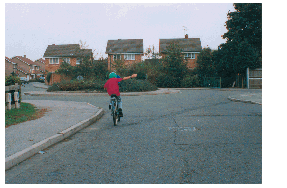
B
C
D
Correct Answer: C
Explanation: Cycling in today's heavy traffic can be hazardous. Some cyclists might not feel happy about crossing the path of traffic to take up a position in an outside lane. Be aware of this and understand that, although they're in the left-hand lane, the cyclist might be turning right.
Explanation: Cycling in today's heavy traffic can be hazardous. Some cyclists might not feel happy about crossing the path of traffic to take up a position in an outside lane. Be aware of this and understand that, although they're in the left-hand lane, the cyclist might be turning right.
Correct Answer: A
Explanation: Keeping the markings clear ensures that drivers and riders passing and children crossing have a clear, unrestricted view of each other.
Explanation: Keeping the markings clear ensures that drivers and riders passing and children crossing have a clear, unrestricted view of each other.
63. You're on a country road. What should you expect to see coming towards you on your side of the road?
Mark one answer
B
C
D
Correct Answer: D
Explanation: On a quiet country road, always be aware that there may be a hazard just around the next bend, such as a slow-moving vehicle or pedestrians. There might not be a pavement and people may be walking on your side of the road.
Explanation: On a quiet country road, always be aware that there may be a hazard just around the next bend, such as a slow-moving vehicle or pedestrians. There might not be a pavement and people may be walking on your side of the road.
64. A horse rider is in the left-hand lane approaching a roundabout. What should you expect the rider to do?
Mark one answer
B
C
D
Correct Answer: B
Explanation: Horses and their riders will move more slowly than other road users. They might not have time to cut across heavy traffic to take up a position in the offside lane when they're turning right; it could also be hazardous for them to do so. Therefore, a horse and rider may approach a roundabout in the left-hand lane, even though they're turning right.
Explanation: Horses and their riders will move more slowly than other road users. They might not have time to cut across heavy traffic to take up a position in the offside lane when they're turning right; it could also be hazardous for them to do so. Therefore, a horse and rider may approach a roundabout in the left-hand lane, even though they're turning right.
65. You're driving through a tunnel. What should you do if your vehicle breaks down?
Mark one answer
B
C
D
Correct Answer: C
Explanation: If your vehicle breaks down in a tunnel, it could present a danger to other traffic. First, switch on your hazard warning lights. If there are passengers in your vehicle, take them to the nearest exit point. You should then call for help from an emergency telephone. Don't rely on being found by the police or being seen by a CCTV camera. The longer a vehicle stays in an exposed position, the more danger it poses to other traffic.
Explanation: If your vehicle breaks down in a tunnel, it could present a danger to other traffic. First, switch on your hazard warning lights. If there are passengers in your vehicle, take them to the nearest exit point. You should then call for help from an emergency telephone. Don't rely on being found by the police or being seen by a CCTV camera. The longer a vehicle stays in an exposed position, the more danger it poses to other traffic.
B
C
D
Correct Answer: C
Explanation: A front tyre bursting will seriously reduce your control of the vehicle. Keep calm and resist the temptation to brake hard or swerve. Hold the steering wheel firmly and try to get the vehicle onto the hard shoulder while allowing it to slow down gradually. Stop as far to the left as possible and switch on your hazard warning lights.
Explanation: A front tyre bursting will seriously reduce your control of the vehicle. Keep calm and resist the temptation to brake hard or swerve. Hold the steering wheel firmly and try to get the vehicle onto the hard shoulder while allowing it to slow down gradually. Stop as far to the left as possible and switch on your hazard warning lights.
67. You're following a motorcyclist along a potholed road. How should you adjust your driving to take account of this situation?
Mark one answer
B
C
D
Correct Answer: B
Explanation: Good forward planning can help you keep other road users out of trouble. Information to help you do this is available if you look for it. Watch for clues: for example, a motorcyclist taking a 'lifesaver' look over their shoulder could be about to change direction.
Explanation: Good forward planning can help you keep other road users out of trouble. Information to help you do this is available if you look for it. Watch for clues: for example, a motorcyclist taking a 'lifesaver' look over their shoulder could be about to change direction.
Correct Answer: D
Explanation: On a poor road surface, the rider may need to move out to avoid potholes. You may not get much warning. A look to the right or a 'lifesaver' check may warn you that they're about to move out. Stay well back and allow the rider plenty of room until you can pass safely.
Explanation: On a poor road surface, the rider may need to move out to avoid potholes. You may not get much warning. A look to the right or a 'lifesaver' check may warn you that they're about to move out. Stay well back and allow the rider plenty of room until you can pass safely.
69. Under EU rules, you can drive for a maximum of nine hours a day. On how many days each week can this be extended to 10 hours?
Mark one answer
B
C
D
Correct Answer: D
Explanation: Under EU rules, your normal daily driving time mustn't exceed nine hours. This nine-hour period is defined as the time between
Explanation: Under EU rules, your normal daily driving time mustn't exceed nine hours. This nine-hour period is defined as the time between
- any two daily rest periods, or
- a daily rest period and a weekly rest period.
B
C
D
Correct Answer: C
Explanation: In icy or snowy weather, your stopping distance can increase by up to ten times. Because snowy weather increases the distance needed to stop, you must look further ahead and leave an increased safety margin.
Explanation: In icy or snowy weather, your stopping distance can increase by up to ten times. Because snowy weather increases the distance needed to stop, you must look further ahead and leave an increased safety margin.
71. What do you need to be aware of when driving a vehicle fitted with power-assisted steering?
Mark one answer
B
C
D
Correct Answer: B
Explanation: Power-assisted steering operates when the engine is running. If a fault develops, much greater effort is required to turn the steering wheel. Don't attempt to drive a vehicle if you're aware of a fault in the power-steering system.
Explanation: Power-assisted steering operates when the engine is running. If a fault develops, much greater effort is required to turn the steering wheel. Don't attempt to drive a vehicle if you're aware of a fault in the power-steering system.
Correct Answer: D
Explanation: Tyres can become very hot during sustained high-speed driving. If they're under-inflated or damaged, there's a risk they'll burst or disintegrate. Check for excessive heat when you stop for a break.
Explanation: Tyres can become very hot during sustained high-speed driving. If they're under-inflated or damaged, there's a risk they'll burst or disintegrate. Check for excessive heat when you stop for a break.
Correct Answer: D
Explanation: Modern large vehicles are fitted with power-assisted steering. If the steering feels heavy, then there's likely to be a fault, which should be investigated and repaired as soon as possible.
Explanation: Modern large vehicles are fitted with power-assisted steering. If the steering feels heavy, then there's likely to be a fault, which should be investigated and repaired as soon as possible.
74. At toucan crossings, pedestrians share the crossing with which other road users?
Mark one answer
B
C
D
Correct Answer: A
Explanation: A toucan crossing is signal-controlled, but unlike a pelican crossing it doesn't have a flashing amber light in the sequence. Cyclists and pedestrians cross together, and cyclists are allowed to ride their bicycles over the crossing.
Explanation: A toucan crossing is signal-controlled, but unlike a pelican crossing it doesn't have a flashing amber light in the sequence. Cyclists and pedestrians cross together, and cyclists are allowed to ride their bicycles over the crossing.
Correct Answer: D
Explanation: When an emergency arises, pull onto the hard shoulder and use the emergency telephone to report your problem. You'll be connected to an operator, who will put you through to a breakdown service. Never cross the carriageway or a slip road to use a telephone.
Explanation: When an emergency arises, pull onto the hard shoulder and use the emergency telephone to report your problem. You'll be connected to an operator, who will put you through to a breakdown service. Never cross the carriageway or a slip road to use a telephone.
B
C
D
Correct Answer: D
Explanation: If you need to brake when the road surface is wet, do so while your vehicle is travelling in a straight line. This will reduce the risk of skidding. As a professional driver, you should routinely brake in good time, so that you don't brake and change direction at the same time.
Explanation: If you need to brake when the road surface is wet, do so while your vehicle is travelling in a straight line. This will reduce the risk of skidding. As a professional driver, you should routinely brake in good time, so that you don't brake and change direction at the same time.
77. You're driving on a road with an uneven surface. What should you do if you're following a motorcyclist along this road?
Mark one answer
B
C
D
Correct Answer: A
Explanation: Never follow any road user too closely. This is particularly important when you're following scooter or motorcycle riders, or cyclists. They might brake or swerve suddenly; for example, to avoid a pothole on a road with a poor surface.
Explanation: Never follow any road user too closely. This is particularly important when you're following scooter or motorcycle riders, or cyclists. They might brake or swerve suddenly; for example, to avoid a pothole on a road with a poor surface.
B
C
D
Correct Answer: C
Explanation: Sometimes other road users disobey the rules or make errors of judgement. Try to accept this calmly and learn from their mistakes.
Explanation: Sometimes other road users disobey the rules or make errors of judgement. Try to accept this calmly and learn from their mistakes.
Correct Answer: D
Explanation: Sometimes other drivers or riders make a mistake. If this happens, try not to let it worry you. Don't react by sounding the horn, flashing your headlights or shouting at the other driver; it won't help the situation. A professional driver will remain calm and stay focused on their driving.
Explanation: Sometimes other drivers or riders make a mistake. If this happens, try not to let it worry you. Don't react by sounding the horn, flashing your headlights or shouting at the other driver; it won't help the situation. A professional driver will remain calm and stay focused on their driving.
80. At an incident, a casualty has stopped breathing. What should you do to help them?
Mark one answer
B
C
D
Correct Answer: B
Explanation: To help a casualty who isn't breathing, you should remove any obstructions from their mouth and tilt their head back slightly. These actions will help to keep their airway clear and maintain the correct position if mouth-to-mouth resuscitation is required.
Explanation: To help a casualty who isn't breathing, you should remove any obstructions from their mouth and tilt their head back slightly. These actions will help to keep their airway clear and maintain the correct position if mouth-to-mouth resuscitation is required.
B
C
D
Correct Answer: C
Explanation: DVSA or the police can order an immediate prohibition. The vehicle may be immobilised and you won't be able to drive it until the faults have been rectified. Details are notified to the traffic commissioner. Never use a vehicle that you know is faulty.
Explanation: DVSA or the police can order an immediate prohibition. The vehicle may be immobilised and you won't be able to drive it until the faults have been rectified. Details are notified to the traffic commissioner. Never use a vehicle that you know is faulty.
82. Bus and lorry tyres have codes on their side walls. What do these codes refer to?
Mark one answer
B
C
D
Correct Answer: C
Explanation: Codes are shown on the wall of the tyre. These refer to the maximum load and speed capability of the tyre.
Explanation: Codes are shown on the wall of the tyre. These refer to the maximum load and speed capability of the tyre.
B
C
D
Correct Answer: C
Explanation: Before leaving your vehicle parked, you must stop the engine. The parking brake must be set and the vehicle should be safe and secure when you leave the cab.
Explanation: Before leaving your vehicle parked, you must stop the engine. The parking brake must be set and the vehicle should be safe and secure when you leave the cab.
B
C
D
Correct Answer: D
Explanation: When turning right onto a dual carriageway, don't stop in the gap in the central reservation unless your vehicle will fit in the gap without any overhang. When it's busy, consider turning left and using a roundabout further up the road so you don't have to cross the central reservation.
Explanation: When turning right onto a dual carriageway, don't stop in the gap in the central reservation unless your vehicle will fit in the gap without any overhang. When it's busy, consider turning left and using a roundabout further up the road so you don't have to cross the central reservation.
Correct Answer: B
Explanation: The main reason why there are so many collisions at junctions is that drivers fail to see motorcyclists. A bright jacket or single headlight may help you identify an approaching motorcyclist, but you should be aware that not all motorcyclists wear bright clothing or use their headlights during the day.
Explanation: The main reason why there are so many collisions at junctions is that drivers fail to see motorcyclists. A bright jacket or single headlight may help you identify an approaching motorcyclist, but you should be aware that not all motorcyclists wear bright clothing or use their headlights during the day.
Correct Answer: B
Explanation: If you're disqualified from driving because you were two-and-a-half times over the legal limit, you'll be classified as a high-risk offender. Before you can regain your licence, you'll have to satisfy the Driver and Vehicle Licensing Agency (DVLA) that you don't have an alcohol problem.
Explanation: If you're disqualified from driving because you were two-and-a-half times over the legal limit, you'll be classified as a high-risk offender. Before you can regain your licence, you'll have to satisfy the Driver and Vehicle Licensing Agency (DVLA) that you don't have an alcohol problem.
Correct Answer: D
Explanation: Parking on the yellow zigzag lines will block the view of the school entrance. This will endanger the lives of children wanting to cross the road on their way to and from school.
Explanation: Parking on the yellow zigzag lines will block the view of the school entrance. This will endanger the lives of children wanting to cross the road on their way to and from school.
Correct Answer: D
Explanation: Slow down when you see a warning sign for an uneven road. Be especially careful if you're carrying passengers, livestock or fragile items.
Explanation: Slow down when you see a warning sign for an uneven road. Be especially careful if you're carrying passengers, livestock or fragile items.
89. You're reversing your vehicle. What should you do while the audible warning device is operating?
Mark one answer
B
C
D
Correct Answer: A
Explanation: Don't rely on an audible warning device to claim right of way. It's your responsibility to be cautious and take all-round observation while you're reversing.
Explanation: Don't rely on an audible warning device to claim right of way. It's your responsibility to be cautious and take all-round observation while you're reversing.
Correct Answer: A
Explanation: Most motoring organisation websites allow you to create a detailed plan of your trip, showing directions and distances. Some also include advice on rest and fuel stops. The Traffic England website will give you information on roadworks and incidents, along with expected delay times.
Explanation: Most motoring organisation websites allow you to create a detailed plan of your trip, showing directions and distances. Some also include advice on rest and fuel stops. The Traffic England website will give you information on roadworks and incidents, along with expected delay times.
91. What would be the most likely effect of driving with the rev counter in the red band?
Mark one answer
B
C
D
Correct Answer: B
Explanation: Driving with the rev counter in the red band will cause the engine to wear prematurely and can lead to expensive repairs. This could result in the vehicle being off the road for some time.
Explanation: Driving with the rev counter in the red band will cause the engine to wear prematurely and can lead to expensive repairs. This could result in the vehicle being off the road for some time.
92. What should you do to help your concentration when you have to drive through the night?
Mark one answer
B
C
D
Correct Answer: B
Explanation: Concentration will be improved by eating regular, light meals timed to fit in with your scheduled rest periods. If you don't eat at all, your blood sugar levels will drop and you'll feel tired. If you just eat snack foods, most of which are sugary or high in fat, your energy levels will peak and then drop - and eating while you're driving is a dangerous distraction.
Explanation: Concentration will be improved by eating regular, light meals timed to fit in with your scheduled rest periods. If you don't eat at all, your blood sugar levels will drop and you'll feel tired. If you just eat snack foods, most of which are sugary or high in fat, your energy levels will peak and then drop - and eating while you're driving is a dangerous distraction.
93. Under EU drivers' hours regulations, a 45-minute break must be taken after 4.5 hours of driving. What shorter breaks can this be split into?
Mark one answer
B
C
D
Correct Answer: B
Explanation: Under EU regulations, you must take a break of at least 45 minutes after four-and-a-half hours of driving. You may choose to take this break during the driving period. In this case, it can be split into two breaks of at least 15 and 30 minutes, taken in that order.
Explanation: Under EU regulations, you must take a break of at least 45 minutes after four-and-a-half hours of driving. You may choose to take this break during the driving period. In this case, it can be split into two breaks of at least 15 and 30 minutes, taken in that order.
94. What's the first thing you should try to do if your vehicle catches fire while you're driving through a tunnel?
Mark one answer
B
C
D
Correct Answer: A
Explanation: If your vehicle catches fire in a tunnel, you should first try to drive it out - but only if you can do so safely.
Explanation: If your vehicle catches fire in a tunnel, you should first try to drive it out - but only if you can do so safely.
Correct Answer: C
Explanation: Driving in an ecosafe manner means that you plan well ahead for hazards and react in good time. This can save fuel and is therefore good for the environment.
Explanation: Driving in an ecosafe manner means that you plan well ahead for hazards and react in good time. This can save fuel and is therefore good for the environment.
Correct Answer: B
Explanation: Individual axle weights are shown on the vehicle plate. This can be found in a prominent place on both the vehicle and trailer.
Explanation: Individual axle weights are shown on the vehicle plate. This can be found in a prominent place on both the vehicle and trailer.
B
C
D
Correct Answer: C
Explanation: The driver's employer is responsible for the issue of tachograph charts. The driver must ensure that the correct information is recorded on the chart.
Explanation: The driver's employer is responsible for the issue of tachograph charts. The driver must ensure that the correct information is recorded on the chart.
98. You're at the scene of a collision. People are injured. What should be done when the risk of further collisions has been dealt with?
Mark one answer
B
C
D
Correct Answer: C
Explanation: Make sure you or someone else has called the emergency services. Check the casualties and, if you feel able to give first aid, do so. Alternatively, ask any bystanders if they can help.
Explanation: Make sure you or someone else has called the emergency services. Check the casualties and, if you feel able to give first aid, do so. Alternatively, ask any bystanders if they can help.
Correct Answer: D
Explanation: This sign tells you that the verge is soft. If you park here, there's a danger that your vehicle will become stuck. This can be inconvenient and could be costly if you need to be pulled out. In extreme cases, your vehicle may even tip over.
Explanation: This sign tells you that the verge is soft. If you park here, there's a danger that your vehicle will become stuck. This can be inconvenient and could be costly if you need to be pulled out. In extreme cases, your vehicle may even tip over.
100. How often must an analogue tachograph be checked at an approved calibration centre?
Mark one answer
B
C
D
Correct Answer: C
Explanation: An analogue tachograph must be checked every two years and recalibrated and sealed every six years. This must be done at an approved calibration centre. Digital tachographs, unlike analogue ones, must be recalibrated every two years.
Explanation: An analogue tachograph must be checked every two years and recalibrated and sealed every six years. This must be done at an approved calibration centre. Digital tachographs, unlike analogue ones, must be recalibrated every two years.


